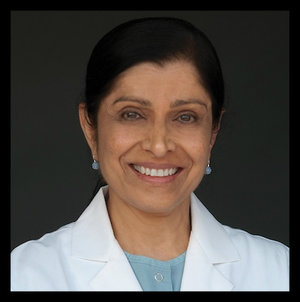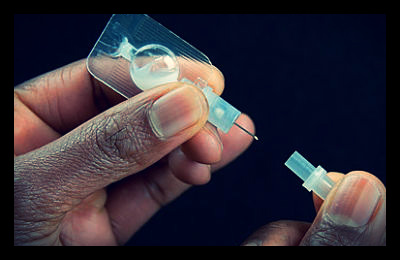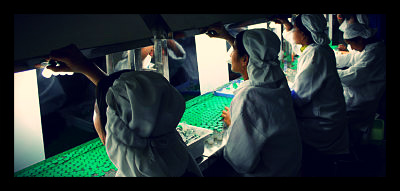
In the wake of AidData’s unveiling of the huge data set of tracking Chinese Aid to Africa, there has been a rather unsettling backlash against the use of data in development. Data is not the problem, it is the overgeneralization of data that is problematic. The Peace Corps case study detailed here focuses on site and project and is time and space specific, resulting in quantifiable success.
One of the latest case studies out of Senegal is about a health system in Karang that was consistently out of stock of urgently needed medications. This Peace Corps Case Study of the Senegalese town on the northern border of the Gambia details the problem and data-driven solutions. The Karang health system has been under the charge of Pauline Sene for 12 years. During this period over 20,000 individuals have been impacted by out of stock medication. The privately owned pharmacy has brand name drugs that are far too expensive for many residents.
Peace Corps Volunteer William Leborgne and Ms. Sene undertook the case study to identify the problems, trends, and solutions to the stock outs.
Ms. Sene and the head pharmacist identified the problems. Peace Corps Volunteer, Mr. Leborgne, aided in research design, data collection, and proposing solutions.
The problems consisted of three parts. First, there was little oversight. The management structure of the health system gave Ms. Sene little ability to oversee the purchasing and daily needs of the medication distribution centers. Second, there was no inventory management system in place to alert upcoming shortages. Finally, the supplier also had stock outs.
The first stage of the case study was data collection. Data collection was conducted over a year and consisted of reorganizing the medicine cabinets, cataloging the inventory, and collecting data on monthly usage. Excel was used for data entry and management. Monthly minimums of medication stock were determined by minimum monthly consumption. Peace Corps Volunteer Leborgne set up an algorithm to alert the staff when a reorder was necessary. By using some of the most common software and accounting available to US retail establishments, Leborgne helped solve the first two problems: oversight and inventory management.
The second stage of the case study was calculating how to minimize stock outs of important medications. Important medications were determined by manipulating the data collected over the year to find peak medication consumption periods. Peace Corps Volunteer Leborgne used the Senegalese government priorities for the medication categories of Malaria prevention, family planning, diarrhea prevention, and high blood pressure.
Findings and recommendations were as follows:
• “The two peak sales periods are Feb-May and Sept-Oct, the biggest month being Oct with sales of half a million CFA – purchasing price (approx. $1000).
• “The base months are Jul-Aug and Nov-Dec where sales drop drastically. The lowest month is December with half the sales of October – approx. $500.
• “We discern a gap in Sept and the start of Oct as these were the peak stock out periods, which coincides with the peak sales periods. This demonstrates the lack of foresight and planning for these peak sales periods.
• “We observe here that 90% of the sales are for just 10 of the 60+ types of medication for sale.”
Spotlighting the 10 medications and using predetermined categories provided by the Ministry of Health, Peace Corps Volunteer Leborgne made the following recommendations:
• “Completely restock the entire inventory in January and August, before the two peak sales cycles.
• “For the 10 top sellers – utilize the data to create an alert system immediately before their peak sales period.
• “Take into consideration the pinnacles of certain illnesses and prepare accordingly, e.g. resupply on Malaria prevention medication in August and Anti-Diarrheal in May.
• “When ordering more, consider the top sellers and the most likely to have shortages – order additional units of these as a precaution.
• “Exploit the alert algorithm within the Excel file in order to keep track of pharmacy stock and re order in a timely fashion.
• “If possible create a 2 month buffer’s worth of medication for the 30 top sellers to counteract the stock outs at the Sokone Hospital (their supplier).”
The grass-roots level of integrated collaboration between the Peace Corps Volunteer Mr. Leborgne, Senegal Government Health Post Ms. Sene, and local pharmacist Salimata Baudian made data collection and commitment to the solution successful. Once implemented by Ms. Sene and the pharmacists, Leborgne’s recommendations proved effective in mitigating stock outs. Between January –April 2013, there have not been any stock outs.
– Katherine Zobre
Source: Peace Corps
Photo: Senegal Health Institute
Editor’s note: PCV William Leborgne gratefully acknowledges the assistance of the AP Statistics classroom at the Edmund Burke School in Washington DC: teacher Rachel Braun, and students Enesh Annaberdieva, and Elizabeth Bennett. As a side benefit, seeking their assistance in the production of statistical tables and summaries has allowed Mr. Leborgne to nurture enthusiasm for international public health among American high school students.








